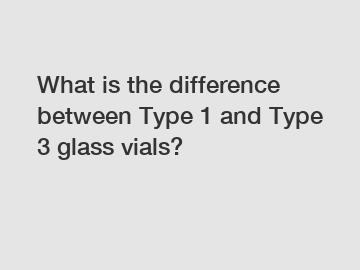What is the difference between Type 1 and Type 3 glass vials?
Glass vials are an essential component in the pharmaceutical and laboratory industries. They are used to store and transport various substances, including medications, vaccines, and chemicals. When it comes to glass vials, there are different types available on the market, with Type 1 and Type 3 being two of the most commonly used varieties. While both types serve the same purpose of containing and preserving substances, there are key differences between them that are important to understand.
Type 1 glass vials are considered to be of the highest quality and are often referred to as borosilicate glass vials. Borosilicate glass is made by adding boron oxide to the traditional glass ingredients of silica and soda lime. This addition of boron oxide results in a glass that is more resistant to thermal shock and chemical corrosion than standard soda-lime glass. Type 1 glass vials are known for their excellent clarity, high chemical durability, and low extractable levels. They are commonly used for storing sensitive substances, such as injectable medications and high-value drugs.
On the other hand, Type 3 glass vials are made from soda-lime glass, which is the most common type of glass used in the production of vials. Soda-lime glass is made from a mixture of silica, soda ash, and lime, which results in a more economical glass option compared to borosilicate glass. While Type 3 glass vials are still suitable for storing many substances, they are less chemically resistant and more prone to thermal shock than Type 1 glass vials. As a result, Type 3 glass vials are typically used for less sensitive substances and applications where cost is a primary consideration.

One of the main differences between Type 1 and Type 3 glass vials is their chemical durability. Type 1 glass vials are highly resistant to attack from acids, bases, and other reactive substances, making them ideal for storing corrosive medications and chemicals. In contrast, Type 3 glass vials are more susceptible to chemical corrosion and may not be suitable for storing certain types of substances that could degrade the glass over time. When selecting a glass vial for a specific application, it is important to consider the compatibility of the vial with the substance being stored to ensure the integrity of the container and its contents.
Another important difference between Type 1 and Type 3 glass vials is their thermal shock resistance. Type 1 glass vials have a higher thermal shock resistance than Type 3 glass vials, meaning they can withstand rapid changes in temperature without cracking or breaking. This property is particularly important for substances that need to be stored or transported at extreme temperatures. Type 3 glass vials may be more prone to thermal shock, which could lead to breakage and potential contamination of the substance being stored. Understanding the thermal characteristics of the glass vial is essential to prevent any damage or loss of the stored substance.
In terms of clarity and transparency, Type 1 glass vials are known for their high-quality finish and excellent clarity, allowing for easy visual inspection of the contents. This is especially important for medications and vaccines that require precise dosing and administration. Type 3 glass vials may have a slightly lower level of clarity due to the properties of soda-lime glass, which could impact the visibility of the contents and make it harder to detect any impurities or contamination. While clarity may not always be a critical factor in selecting a glass vial, it can play a significant role in ensuring the quality and integrity of the stored substance.
When it comes to cost, Type 1 glass vials are typically more expensive than Type 3 glass vials due to the higher quality of borosilicate glass and the additional processing required to manufacture them. While the initial cost of Type 1 glass vials may be higher, the superior chemical durability and thermal shock resistance of these vials could result in long-term savings by reducing the risk of breakage and contamination. Type 3 glass vials are a more economical option for applications where cost is a primary concern and the stored substances are less sensitive to potential chemical interactions.
In conclusion, the choice between Type 1 and Type 3 glass vials will depend on the specific requirements of the application and the characteristics of the substances being stored. Type 1 glass vials are best suited for storing sensitive medications, vaccines, and chemicals that require high chemical durability and thermal shock resistance. Type 3 glass vials are a cost-effective option for less sensitive substances and applications where the risk of breakage or contamination is minimal. By understanding the differences between these two types of glass vials, you can make an informed decision to ensure the safe and effective storage of your valuable substances.
The company is the world’s best empty glass ampoules, vials manufacturer for injection, borosilicate glass tube suppliers supplier. We are your one-stop shop for all needs. Our staff are highly-specialized and will help you find the product you need.

Comments